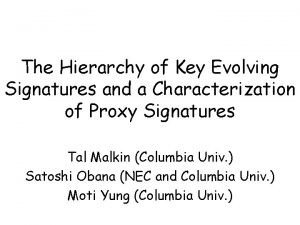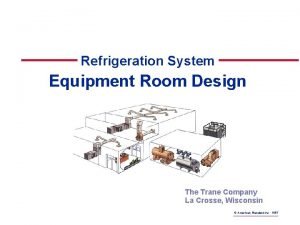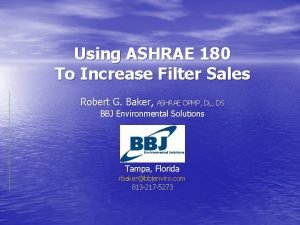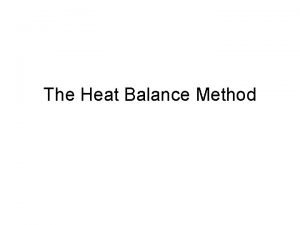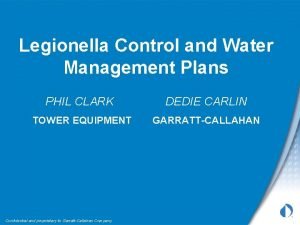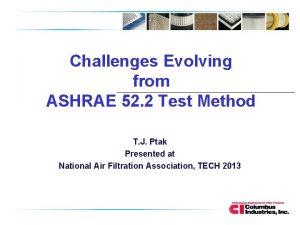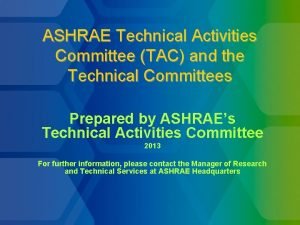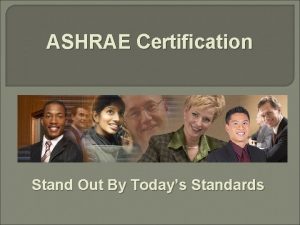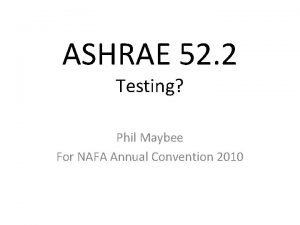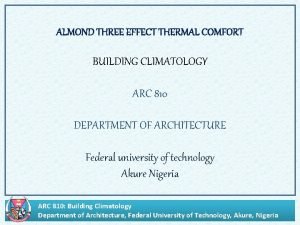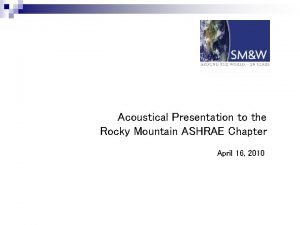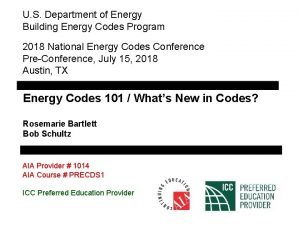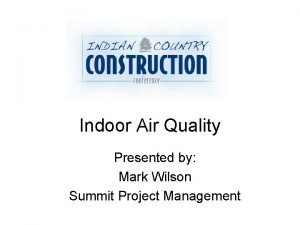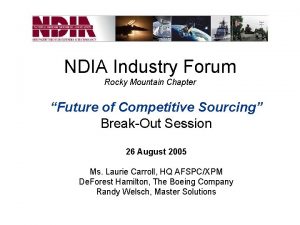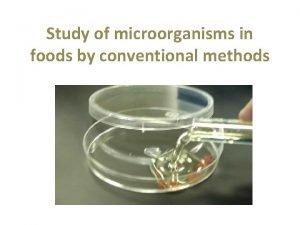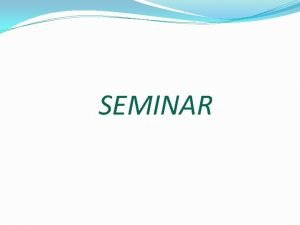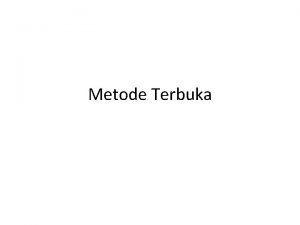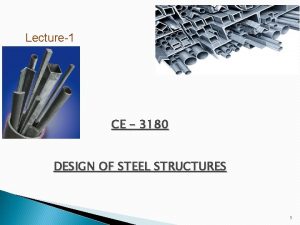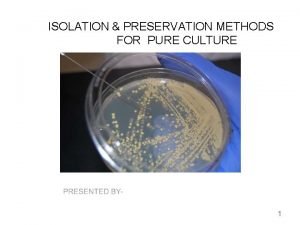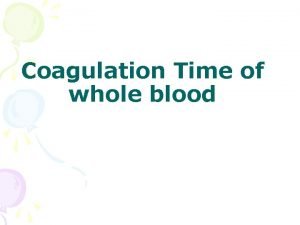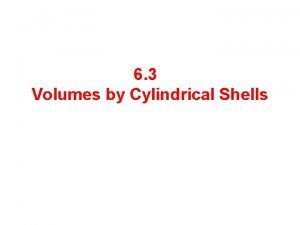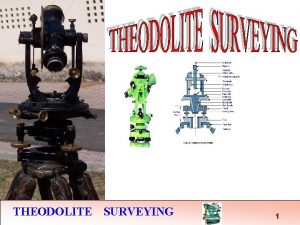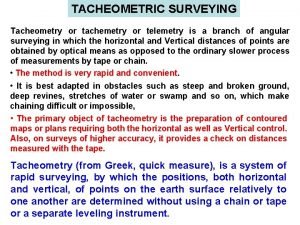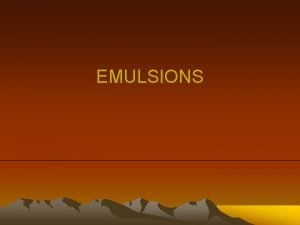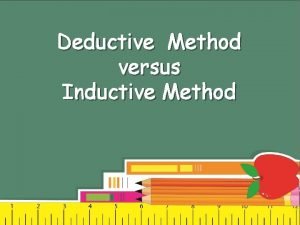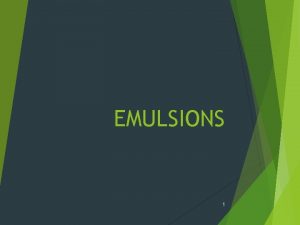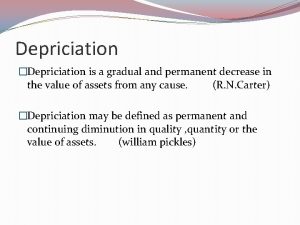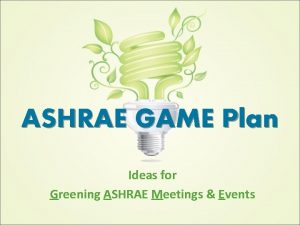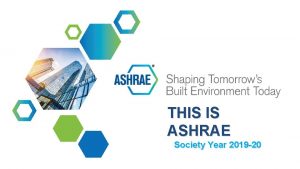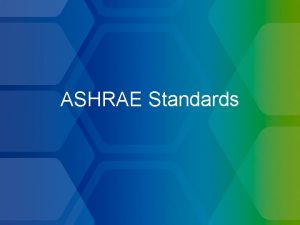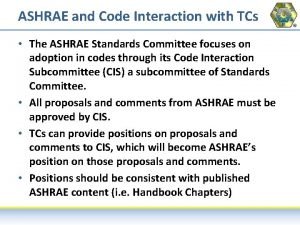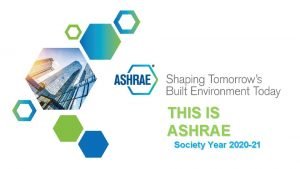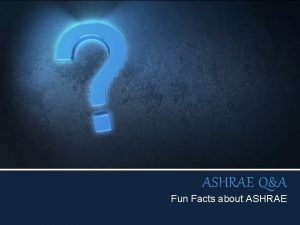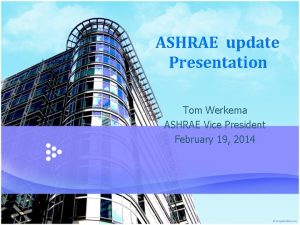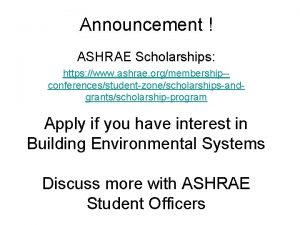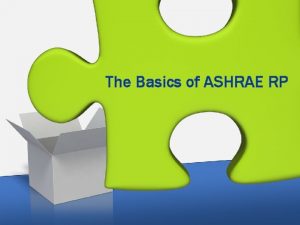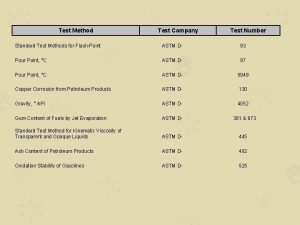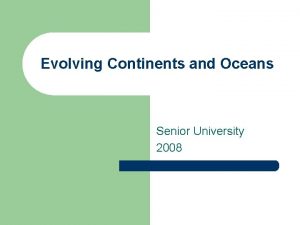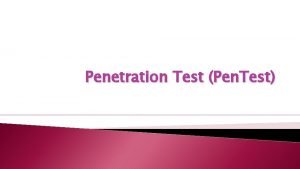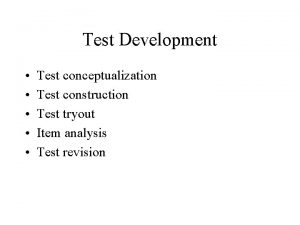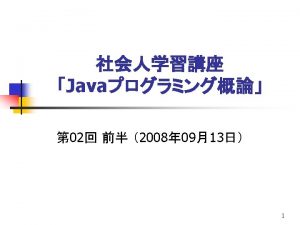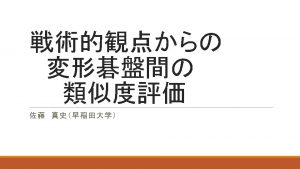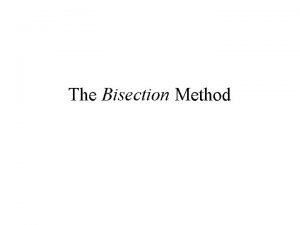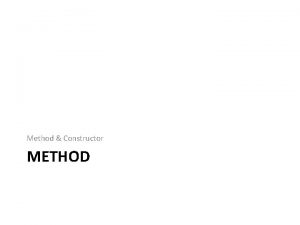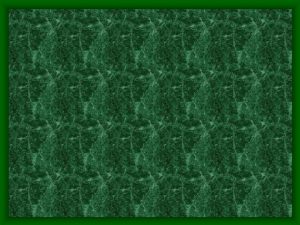Challenges Evolving from ASHRAE 52 2 Test Method






















![Sources of Variability – Dust Holding Capacity Filter Average DHC, [gram] 95% Confidence, 2 Sources of Variability – Dust Holding Capacity Filter Average DHC, [gram] 95% Confidence, 2](https://slidetodoc.com/presentation_image/f9f02bf0b4bcf3a698c845f84cc51817/image-23.jpg)














- Slides: 37

Challenges Evolving from ASHRAE 52. 2 Test Method T. J. Ptak Presented at National Air Filtration Association, TECH 2013

Scope q. Introduction q. Test methods q. ASHRAE 52. 2 test method q. Current variability q. Potential causes of variability q. ASHRAE 52. 2 – Conditioning method q. Conclusions

Test Method q Definition (ASTM) “Definitive procedure for the identification, measurement, or evaluation of one or more qualities, characteristics, or properties of a material, product, or system” q General Requirements q. Test method must measure characteristic or property that will predict usefulness of a product when it is put to its intended use q. Test method is supposed to predict performance in later stage in the life of a material or product

Test Method q. Main Components and Steps q. Test procedures q. Test method tolerances q. Reducing variability q. Determine sources of unnecessary variability q. Ruggedness test q. Procedure for interlaboratory testing q. It is not for detecting and eliminating sources of variability q. Precision and bias

ASHRAE 52. 2 – Performance Characteristics q Test standard – ASHRAE 52. 2 q. Differential pressure q. Fractional efficiency for particle size range 0. 3 – 10 µm q. Initial, intermediate and final q. Dust holding capacity at specified terminal ΔP q. Reporting q. PSE curve after each step of dust loading q. Develop a composite minimum efficiency curve q. Report average E 1 0. 3 – 1. 0 µm E 2 1. 0 – 3. 0 µm E 3 3. 0 - 10 µm q. MERV - Minimum Efficiency Reporting Value

ASHRAE 52. 2 –Check List q Differential pressure q Efficiency q. Initial q. Intermediate q. Final q Filter life q Tolerances q Process to reduce variability q Precision and other statistics + + +/+/- - (+) -

ASHRAE 52. 2 – Current Situation q Round Robin Test – report issued in 2005 q 1088 -RP – Coordinate and Analyze Interlaboratory Testing of Filters under ASHRAE 52. 2 q Differences between laboratories q. Differences still exist q. SSPC 52. 2 activities

ASHRAE 52. 2 – Round Robin Test q Round Robin Test sponsored by ASHRAE* q. Participating labs q. Selected filters 8 4 o Type 1 – 24 x 12” glass (MERV 10 -11) o Type 2 – 24 x 4” electret (MERV 8 -11) o Type 3 – 24 x 4” cotton/PET (MERV 5 -7) o Type 4 – 24 x 12” electret (MERV 15 -16) o Filters were pre-tested at independent lab q Statistical methodology o Repeatability – precision of the method within a given lab o Sr – repeatability standard deviation o Reproducibility - precision of the method when comparing labs o SR – reproducibility standard deviation NOTE: * from ASHRAE 1088 -RP

ASHRAE 52. 2 – RRT Variability q Round Robin Test results q. Precision statistics for pressure drop measurement o Repeatability CV o Reproducibility CV 1. 8 – 6. 7% 5. 3 – 6. 8% q. Precision statistics for weight gain o Repeatability CV o Reproducibility CV 7. 5 – 26. 5% 8. 1 – 26. 5% q. MERV summary o Type 1 (1 st stage) o Type 2 o Type 3 o Type 4 MERV 11 (5); MERV 10 (1) MERV 8 (9); MERV 10 (1); MERV 11 (2) MERV 5 (1); MERV 6 (10); MERV 7 (1) MERV 14 (4); MERV 15 (8)

ASHRAE 52. 2 - RRT Variability q Round Robin Test results q. Precision statistics for Type 4 filters o Repeatability Sr Reproducibility SR E 1 – 1. 71; E 2 – 0. 50; E 3 – 0. 0 E 1 – 2. 63; E 2 – 0. 93; E 3 – 0. 41 q. Precision statistics for Type 3 filters o Repeatability Sr Reproducibility SR E 1 – 1. 91; E 2 – 2. 42; E 3 – 3. 94 E 1 – 2. 61; E 2 – 3. 88; E 3 – 4. 98 q. Precision statistics for Type 2 filters o Repeatability Sr Reproducibility SR E 1 – 2. 86; E 2 – 4. 99; E 3 – 2. 45 E 1 – 5. 00; E 2 – 6. 05; E 3 – 3. 04 q Calculated 95% confidence interval for individual results o “ 2 Sr “ = 1. 96 Sr o “ 2 SR ” = 1. 96 SR

ASHRAE 52. 2 – RRT Variability q What does it mean for filter users? q. Pressure drop Filter Type 2 Type 3 Type 4 Average ΔP, [in. H 2 O] 95% Confidence, 2 SR 95% Confidence range 0. 34 ± 0. 05 0. 29 – 0. 39 0. 28 ± 0. 03 0. 25 – 0. 31 0. 76 ± 0. 11 0. 65 – 0. 87 Type 2 197 ± 32 165 – 229 Type 3 248 ± 44 204 – 292 Type 4 138 ± 72 66 – 210 q. Dust holding capacity Filter Average DHC, [gram] 95% Confidence, 2 SR 95% Confidence range

ASHRAE 52. 2 – RRT Variability q What does it mean for filter users? Filter Type 2 Average efficiency E 1=19 E 2=57 E 3=82 95% Confidence, 2 SR 95% Confidence range MERV 10 MERV 11 10 2 – 29 12 45 – 69 >50 >65 6 77– 88 >85 q Is the current situation acceptable? q. Statistical evaluation can not be applied to MERV q. Report was published in 2005 q. ASHRAE SSPC 52. 2 activities q. Significant variability still exist

ASHRAE 52. 2 - Potential Sources of Variability q General requirements: q. Test duct configuration q. Specified dimensions, locations of measuring points, transitions q Straight test duct, U - shaped q. Particle counters q Optical particle counter, (OPC) q Aerodynamic particle counter, (APC) q. Other test instruments q. Pressure gauges q. Flow meter q. Aerosol generation q. Dust feeder manometer ASTM nozzle atomizing nozzle

ASHRAE 52. 2 - Potential Sources of Variability q General requirements: q. Recommended range of flow rate q 472 – 2990 cfm q. Air velocity 118 – 748 fpm q. Air velocity 492 fpm if not specified (for residential 295 fpm) q. Recommended range for temperature and relative humidity q. T = 50 – 100 o. F q. RH = 20 – 65% q. Challenge aerosol q. KCl q. Loading dust q. ASHRAE dust (75% - SAE J 726 dust; 23% powdered carbon; 5% milled cotton linters)

ASHRAE 52. 2 – Residential Filtration q Test method is not applicable to: q. Electrostatic precipitators q. Hybrid filters with external electrostatic field q Selection of the air velocity – historical approach q 1 inch deep filters tested at 295 fpm q 4 inch deep filters tested at 492 fpm q. Confusion with claims and test results q. Claims for 1 inch filters based on V = 295 fpm q. Claims for 4 inch filters based on V = 492 fpm

ASHRAE 52. 2 - Performance of Selected Filters Filter dimensions 20 x 25 x 4 and 20 x 25 x 1 in. Filter pressure drop Q=1024 cfm Q=1708 cfm 0. 60 MERV 8 Pressure drop, in. H 2 O 0. 50 MERV 13 0. 40 MERV 16 MERV 12 - 1 in. 0. 30 0. 20 0. 10 0. 00 0 400 800 Flow rate, cfm 1200 1600 2000

ASHRAE 52. 2 - Performance of Selected Filters Filter dimensions 20 x 25 x 4 and 20 x 25 x 1 in. Filter efficiency at 1200 cfm 100 Efficiency, [%] 80 60 MERV 8 - E 1 = 27. 1% Glass panel - E 1 = 0% 40 MERV 16 - E 1 = 95. 8% MERV 12 - 1 in. E 1 = 55. 1% 20 0 0. 35 0. 48 0. 63 0. 85 1. 15 1. 45 1. 9 Particle size, micron 2. 6 3. 5 4. 75 6. 25 8. 5

ASHRAE 52. 2 - Performance of Selected Filters Filter dimensions 20 x 25 x 4 and 20 x 25 x 1 in. Filter efficiency at 2000 cfm 100 Efficiency, [%] 80 60 40 MERV 8 - E 1 = 23. 0% MERV 16 - E 1 = 94. 8% 20 MERV 12 - 1 in. E 1 = 50. 7% 0 0. 35 0. 48 0. 63 0. 85 1. 15 1. 45 1. 9 Particle size, micron 2. 6 3. 5 4. 75 6. 25 8. 5

Sources of Variability – Filter Pressure Drop q Pressure drop data from RRT Filter Average ΔP, [in. H 2 O] 95% Confidence, 2 SR 95% Confidence range Type 2 0. 34 ± 0. 05 0. 29 – 0. 39 Type 3 0. 28 ± 0. 03 0. 25 – 0. 31 Type 4 0. 76 ± 0. 11 0. 65 – 0. 87 q Temperature and relative humidity range q Potential sources of variability q. Pressure drop across empty section q. Pressure drop gauge accuracy ΔP<0. 03” wg. ± 2. 5% (? ) q. Differential pressure transducers are used for convenience q. Generally it is ± 0. 25% of full scale q. For gauge 0 -10” wg. range ± 0. 025” wg.

Sources of Variability – Filter Pressure Drop q. Measurement of flow rate q. ASME long-radius nozzle q. Uncertainty of ± 2% for nozzles with beta = 0. 2 -0. 8 q. Surface finish 16 RMS (16 micro inches) q. Calibrated nozzle can have accuracy as low as ± 0. 25% q. Required input – temperature, air density, pressure q. Laminar flow elements are used flow measurements q. Better accuracy, generally 0. 8% of reading q. LFE with accuracy =1% and flow rate Q=2000 cfm q. Flow measurement accuracy is ± 20 cfm → ΔP > 0. 01” wg q. Pressure drop measurement across ASME nozzle q. No information on filter pressure drop at high elevation, correction for temperature, humidity

Sources of Variability – Filter Efficiency q. Temperature and relative humidity range q. Impact of relative humidity on particle size q. Particle counters q. Optical particle counter q. Flow rate 0. 1 cfm; ± 2% q< 10% coincidence error at 300, 000 particles/min q. Aerodynamic particle counter q. No requirements q. Aerosol neutralization q. Radioactive (beta or gamma) with activity >5 m. Ci q. Corona discharge with 3 µA current q. Annual measurement of activity is recommended

Sources of Variability – Filter Efficiency q. Dust migration after dust loading q. Airflow for 20 minutes q. Duration less than 20 minutes is allowed if release rate <5% q. Potential duct contamination due to dust loading q. Dust loading is sometimes performed in a different test duct q. Potential particle settling at low air velocity q. Issues with statistical evaluation q. Ruggedness Tests could find variables that strongly influence measurements
![Sources of Variability Dust Holding Capacity Filter Average DHC gram 95 Confidence 2 Sources of Variability – Dust Holding Capacity Filter Average DHC, [gram] 95% Confidence, 2](https://slidetodoc.com/presentation_image/f9f02bf0b4bcf3a698c845f84cc51817/image-23.jpg)
Sources of Variability – Dust Holding Capacity Filter Average DHC, [gram] 95% Confidence, 2 SR 95% Confidence range Type 2 197 ± 32 165 – 229 Type 3 248 ± 44 204 – 292 Type 4 138 ± 72 66 – 210 q. Temperature and relative humidity range q. Test dust and filter components are to some degree hygroscopic – increase weight when exposed to high RH q. Size distribution of ASHRAE dust q. Potential difference between filter and dust loaded in two different test rigs

ASHRAE 52. 2 - Conditioning q. Initial conditioning with a dust loading of 30 grams or increase pressure drop by ΔP=0. 04” wg. q. Real life test data for filter efficiency made of some electrostatically enhanced media is lower q. Research has been initiated to simulate this behavior q. ASHRAE 1190 -RP – Develop a New Loading Dust q. Other conditioning methods: q. Exposure to diesel soot q. Exposure to cigarette smoke q. Exposure to ultrafine particles q. Exposure to alcohol (spray, dip, vapor) Conditioning = removal of electrostatic enhancement? Conditioning = simulation of real life performance?

ASHRAE 52. 2 - Conditioning q Impact of the initial loading on efficiency 100 Efficiency, [%] 80 60 40 24 x 4 in. Filter initial 24 x 4 in. Filter after 1 st loading 20 0 2 4 Particle size, [µm] 6 8

NIOSH - Conditioning q How do other organizations test filters? q National Institute for Occupational Safety and Health (NIOSH) q. Procedure for testing particulate respirators – 42 CFR 84 regulation q 3 types of class of filters: Class Agent Load Particle size N-Series Na. Cl 200 g 0. 3 µ R-Series DOP oil 200 g 0. 3 µ P-Series DOP oil stabilized 0. 3 µ

NIOSH - Conditioning q Loading with Na. Cl particles using TSI 8130 After alcohol P=50% After alcohol P= 30%

ASHRAE 52. 2 - Conditioning q MERV 15 filter tested at 492 fpm q Electrostatically enhanced material Different conditioning process 100 80 80 60 Efficiency, [%] q Field test data Initial efficiency After 3 weeks 40 After 5 weks 60 Initial efficiency Treated with alcohol 40 After field test After 8 weeks 20 0. 4 0. 75 3 Particle size, micron After conditioning 5 20 1 2 3 Particle size, micron 4

ASHRAE 52. 2 - Conditioning High Efficiency Electrets q Performance after loading with cigarette smoke, combustion particles and real life q. Initial Efficiency at 0. 3 µm particles, E >99. 99% Treatment 12 months real life 300 cigarettes Diesel soot (60 min)at 450 µg/m 3 Efficiency, [%] 99. 98 >99. 97 What would be efficiency of this filter after alcohol ?

ASHRAE 52. 2 – Conditioning q Exposure to alcohol q Limitations: q. Does not simulate real life q. Can not be applied to filters with external electric field q. Can not be applied to gas phase filters, PCO, UV q. Can affect filters with surface tackifiers q. Can affect high efficiency electrets q Conditioning with UFP particles (ASHRAE 52. 2 J) q. Eliminates all the above concerns q. Test method requires some improvements to reduce variability

ASHRAE 52. 2 – Conditioning App. J q. ASHRAE 52. 2 Appendix J (1190 -RP) q. Size distribution of challenge aerosol - number 1, 200, 000 1, 000 800, 000 600, 000 400, 000 200, 000 0 0. 0 10. 0 20. 0 30. 0 40. 0 50. 0 60. 0 Particle size, nm 70. 0 80. 0 90. 0 100. 0

ASHRAE 52. 2 – Conditioning App. J q. Ambient aerosol – size distribution

ASHRAE 52. 2 - Conditioning App. J and Field Test q Can mechanical media be affected by conditioning q. Field test and conditioning – high efficiency mechanical Field test Conditioning 100 90 Initial 80 1 st stage Efficiency, [%] 95 85 Initial 1 st stage 2 nd stage 3 rd stage 75 70 0 1 Particle size, [µm] 0. 1 1 Particle size, [µm]

ASHRAE 52. 2 - Conditioning App. J and Field Test q Can mechanical media be affected by conditioning q. Field test and conditioning – high efficiency electret Field test Conditioning 100 Efficiency, [%] 80 Initial 1 st stage 70 2 nd stage Efficiency, [%] 90 90 80 70 Initial 1 st stage 2 nd stage 60 N stage 3 rd stage 50 60 0. 1 1 Particle size, [µm]

ASHRAE 52. 2 - Conditioning App. J and Field Test q Can mechanical media be affected by conditioning q. Field test and conditioning – MERV 8 mechanical Field test Conditioning 80 60 60 Initial 40 1 st stage 2 nd stage 20 Efficiency, [%] 80 40 Initial 20 1 st stage 3 rd stage 2 nd stage 4 th stage 0 0 0 2 4 6 Particle size, [µm] 8

ASHRAE 52. 2 – Conditioning Summary q Conditioning method according to the ASHRAE 52. 2 Appendix J should be used in filter testing q. Simulates better real life performance q. Requires some improvements q Flat sheet test of filter media according to this test method is an inexpensive and not time consuming q Alcohol treatment should be used only to determine if filter material poses an electrostatic charge q. Severely overestimate performance degradation

Conclusions q Variability of the ASHRAE 52. 2 test method is not acceptable q Results from Round Robin Test and other Research Projects (PR) were never implemented q. Reproducibility q Some variability sources could be quickly evaluated by conducting Ruggedness Tests q Conditioning test method according to the Appendix J should be improved and adopted as a test method
 Evolving design
Evolving design A framework for clustering evolving data streams
A framework for clustering evolving data streams Key evolving signature
Key evolving signature Evolving
Evolving Chiller room ventilation requirements
Chiller room ventilation requirements Ashrae standard 202 pdf
Ashrae standard 202 pdf Ashrae 180
Ashrae 180 Heat transfer function
Heat transfer function Ashrae 188 water management plan
Ashrae 188 water management plan Ashrae 52
Ashrae 52 Ashrae tac
Ashrae tac Ashrae membership renewal
Ashrae membership renewal Ashrae 52
Ashrae 52 Effective temperature in climatology
Effective temperature in climatology Ashrae
Ashrae Ashrae
Ashrae Ashrae
Ashrae Rocky mountain ashrae
Rocky mountain ashrae Www.ashrae.org membership
Www.ashrae.org membership Symposium introduction
Symposium introduction Pour plate method steps
Pour plate method steps Characteristics of bilingual method
Characteristics of bilingual method Metode terbuka
Metode terbuka Working stress method and limit state method
Working stress method and limit state method Isolation of pure cultures
Isolation of pure cultures Dry gum method definition
Dry gum method definition Clotting time methods
Clotting time methods Volume by cylindrical shells examples
Volume by cylindrical shells examples Reiteration method in surveying
Reiteration method in surveying Uses of tacheometric surveying
Uses of tacheometric surveying Royalty income
Royalty income Classification of emulsifying agents
Classification of emulsifying agents Inductive and deductive reasoning
Inductive and deductive reasoning The army method of language teaching
The army method of language teaching Approach in teaching
Approach in teaching Bottle method of emulsion
Bottle method of emulsion How to use direct method in teaching english
How to use direct method in teaching english Fixed installment method and diminishing balance method
Fixed installment method and diminishing balance method


